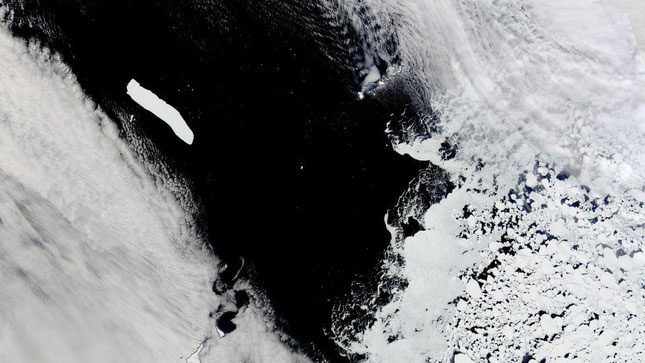A new satellite image reveals that the world’s largest iceberg, A-76A, has entered the Drake Passage, a waterway with fast-moving currents that will carry the iceberg in one direction and lead to its complete melting.
After drifting slowly around Antarctica for over a year with little melting, the world’s largest iceberg may soon be on a rapid trajectory toward its eventual collapse, a new satellite image shows.

This image, captured by NASA’s Terra satellite on October 31, shows the world’s largest iceberg, A-76A, in the Drake Passage near Antarctica.
The massive iceberg, known as A-76A, measures approximately 135 kilometers long and 26 kilometers wide. It is the largest fragment of the previously largest iceberg, A-76, which was the size of Rhode Island. A-76 broke away from the western side of the Ronne Ice Shelf in Antarctica in May 2021 and subsequently fractured into three pieces: A-76A, A-76B, and A-76C.
On October 31, NASA’s Terra satellite captured an image of A-76A floating in the Drake Passage, a deep waterway connecting the Pacific and Atlantic Oceans between Cape Horn in South America and the South Shetland Islands north of the Antarctic Peninsula.
The image shows the iceberg currently situated between Elephant Island and the South Orkney Islands (both obscured by clouds in the image) at the southern end of the passage, but its trajectory indicates that it will move further north into the waterway in the coming weeks. The image was released online on November 4 by NASA’s Earth Observatory.
Typically, when icebergs drift into the Drake Passage, they are quickly swept eastward by strong currents before being pulled north into warmer waters, where they melt completely shortly thereafter, according to the Earth Observatory.
So far, A-76A has traveled approximately 2,000 kilometers since breaking away from the Antarctic Peninsula in 2021. This iceberg has managed to avoid significant ice loss throughout its journey up to this point. Data collected by the U.S. National Snow and Ice Data Center in June shows that A-76A is nearly the same size as when it broke off from its parent body over a year ago, according to the Earth Observatory.
However, it is unlikely to remain intact for much longer, as the Drake Passage is notorious for carrying icebergs on a one-way trip to their watery graves. The primary reason for this phenomenon is the Antarctic Circumpolar Current (ACC), which is the only current that flows entirely around the globe and carries more water than any other current on Earth.
The ACC, flowing from west to east through the Drake Passage, transports between 95 and 150 million cubic meters of water per second, according to Britannica. As a result, wandering icebergs entering the Drake Passage are quickly pulled away from Antarctica and deposited in warmer waters, where they rapidly disintegrate.
It remains unclear how long A-76A will stay in the Drake Passage, where it will ultimately end up, and how long it will survive after the turbulent current carries the ice mass northward.


















































